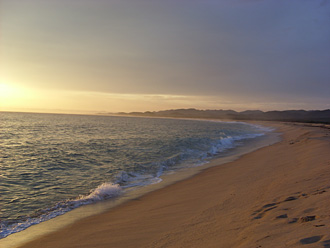
|  |  |  News from Around Banderas Bay | July 2008 News from Around Banderas Bay | July 2008  
For Turtles Mayto Beach is Paradise Found
 Alice Carter-Tyler - PVNN Alice Carter-Tyler - PVNN


| | Every year from July to November, Mayto Beach, a little piece of paradise two hours south of Puerto Vallarta, provides a nesting ground for hundreds of Olive-Ridley turtles - and one group of biologists and volunteers is working to protect them. | | |
Amongst the many gems of Banderas Bay, lies Mayto Beach. A little piece of paradise, two hours drive on dirt track southwards from Puerto Vallarta through El Tuito will bring you here. One of few unspoiled beaches, where only a handful of buildings line the shoreline, sympathetically styled with palm leaf roofs and wooden shacks.

Between July and November each year this idyllic location provides a nesting ground for hundreds of Olive-Ridley turtles. After hatching from their eggs, each turtle can grow up to 2 and half feet and 110 lbs in weight. Once in the ocean, these omnivores dive 150m to the sea bed in order to feed on crustaceans, shrimp and fish.

If allowed to continue their journey in peace, once they have been immersed in to ocean as hatch lings they can live for over 100 years. The current record for the oldest turtle was found to be 120 years old in 2006. However, there are many threats to these gentle creatures and since the 1970's turtle conservation camps have been set up in order to give turtles higher chances of survival.

Directly on Mayto Beach, lies the camp for the protection of the Marine Turtles. For 3 years now, the biologists here have strived to ensure the safety of the Olive-Ridley turtle. Funded by Guadalajara University and watched over by CONAM, the governmental environment sector, volunteers work alongside biologists to carefully record data and monitor turtle numbers.

Every night, torches scour the coastline looking for signs of turtles and their nests. A biologist at the camp commented that, depending on sand conditions, on average it takes the turtles 20 minutes to dig a hole and lay their eggs on the shore. On discovery, the nests are carefully dug up and their contents removed. Back at camp, the eggs are buried 40cm under the sand in a marked secure area, watched over by devoted staff in order to grow and hatch in peace and safety.

Their help is greatly needed, for turtles are under threat from the minute they are laid and buried deep beneath the sand. Aside from birds, sharks, larger predators and fish, the turtles face a threat from poachers.

Turtle egg poaching has occurred for years, the unhatched eggs considered a delicacy to eat themselves or to sell on to others. The further inland the eggs reach, the higher prices they are sold for. A highly illegal practice with a long spell in prison as a consequence, the conservationists endeavor to protect the eggs from the hands of such people. Mayto Beach itself not heavily targeted, the beaches of Mismaloya are hot targets for poachers.

Once the eggs are hatched, turtles dig their way to the surface of the sand, where the biologists rapidly assist to uncover around one hundred turtles per nest. These turtles are rinsed and allowed to rest, while waiting for nightfall and their release.

Over the summer of 2007, approximately 80 nests were hatched at Mayto Beach alone, keeping all who worked there very busy! The hatch lings are released in large numbers at night, in order to minimise the risk of predation where they must then search for rocks by which to hide while they gain nourishment and strength to continue their journey. With few defences, the turtles are susceptible to injury and have been known to return to Mayto Beach having had a limb taken by a preying shark.

Once turtles have reached reproductive age at around 8-12 years, they return to the beach on which they were born to lay their own eggs. An inbuilt magnetism allows them to track down their place of birth to within 100m on a stretch of coastline. Despite the best efforts of the conservationists to ensure the best start in life for the hatch lings, Jorge, an on site biologist remarked "Only two out of every hundred survive to reach adult age."

While all the turtles released so far are making their way towards the Japanese coast, the staff continue to nurture the turtles back at camp, something the locals of Mayto are happy to see happening. Bringing interest to the area can only be good for their prosperity.

Yet, with all the good work that the conservationists and essential volunteers are doing, a part of me hopes that this area will stay a little piece of paradise, to ensure a calm, peaceful environment to which many a turtle can return.
 Alice Carter-Tyler is a participant with Global Volunteer Projects. Having travelled to Puerto Vallarta, Mexico from Devon, England; she is working as an intern with BanderasNews as part of Global Volunteer's Journalism placement project for the month of July 2008. In October 2008, she is starting her studies in English at University, after which she plans to pursue a career with journalistic influences. Alice Carter-Tyler is a participant with Global Volunteer Projects. Having travelled to Puerto Vallarta, Mexico from Devon, England; she is working as an intern with BanderasNews as part of Global Volunteer's Journalism placement project for the month of July 2008. In October 2008, she is starting her studies in English at University, after which she plans to pursue a career with journalistic influences. |

 |
|  |



